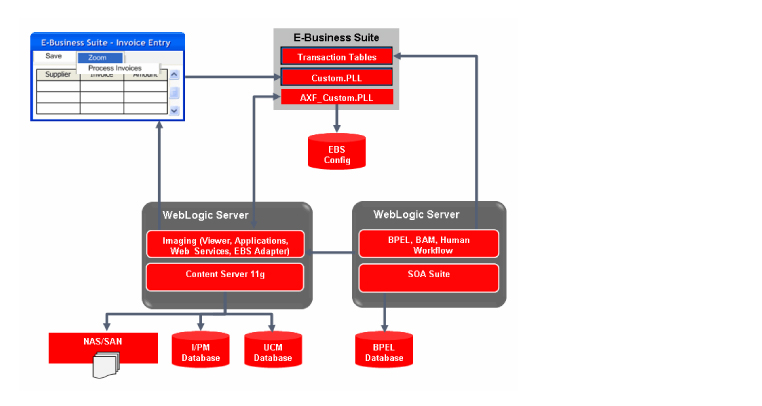This course deals with understanding the architecture of Oracle B2B in setting up eCommerce Gateway for exchange of business documents (EDI/RosettaNet), and introduces the concepts and implementation of Service Oriented Architecture (SOA) using Oracle SOA Suite 11g. Hands on labs are provided to build complete integration scenario of Inbound Purchase Order and Outbound Invoice document flow. This involves setting up Oracle B2B (with EDI-X12/RosettaNet) and enabling the integration with Oracle EBusiness Suite using Oracle SOA Suite 11g. We shall aim in configuring one outbound flow of 850 Purchase Order document from Ebusiness Suite and one inbound flow of 855 Purchase Order Acknowledgement from Trading Partner to Oracle Ebusiness Suite utilizing Oracle SOA Suite 11g

Prerequisites
- Knowledge of XML technologies (XML, XSD, XPATH)
- Knowledge of Web service technologies (WSDL, SOAP, and UDDI)
- Learn Integration/Interfacing options with EBusiness Suite and Siebel
- Understand SOA concepts and technology
- Work with Oracle Fusion Middleware Adapter for EBusiness Suite
- Work with Oracle Fusion Middleware Adapter for Siebel
- Create SOA Composite application using JDeveloper
- Orchestrate business process flows by using BPEL
- Work with Mediator components for routing and transformations
- Perform administration and monitoring tasks of SOA Composite applications
- Test, debug, and troubleshoot a SOA Composite application
- Build real-time operational dashboards, monitoring and alerting applications with Oracle BAM
Part I – Oracle SOA Introduction, Oracle BPEL and JDeveloper
Introduction to SOA Suite 11g
- Introduction to SOA Suite 11g
- Introduction to SOA Composites
- Understand SOA Composite components
- Introduction to SOA Composite Editors
BPEL basics (introduce BPEL and activities)
- The basic concepts of Oracle BPEL Process Manager
- Oracle BPEL Process Manager Implementation Options
- Oracle BPEL Process Manager Designer
- BPEL PM Designer Layout – the Integration Perspective
- Creating a BPEL Process
- Adding Activities
- XPath Expression Builder
- XPath Functions
- Deploying the BPEL Process
- Exploring Oracle BPEL Console (Administer and Monitor processes)
Orchestrating Services with BPEL
- BPEL Process Modeling Support in JDeveloper
- Importing XML Schemas and WSDL Locators
- Support for Validation, Deployment, and Lifecycle Management
- Orchestrate services through BPEL for a Synchronous Service
- Orchestrate services through BPEL for an Asynchronous Service
- Partner Link Concepts and Use
Fault Handling and Exception Management
- Defining Events
- Configuring Timeouts
- Handling Faults
- Catching Exceptions
- Compensation Management
Transformation Services
- Transformation Service and Tool
- Functions (Standard, User, and Extended)
- Map Testing and Analysis
- XSLT Mapping Tool
- Auto Mapping
Part II – Oracle AS Adapters (Database and File) & Oracle Mediator
Adapters
- Adapter Concepts
- Configuring Database Adapter
- Configuring File Adapter
Introduction to Oracle Mediator
- Mediator concepts
- Mediator Architecture
- Creating, Configuring, and Managing Oracle Mediator
- Managing Oracle Mediator Components
Routing Services and Routing Rules
- Introducing routing services and routing rules
- Specifying routing services
- Specifying Routing Rules
- Working with Transformation
- Working with Filters
XSLT Data mapper and Transformations
- Introduction to XSLT Data mapper
- Using Data mapper to create xsl
- Mapping basics
- Adding functions
- Working with XPATH expressions
- Auto mapping
- Testing the Map
Domain-Value Maps
- Introduction to domain value map
- Creating and populating DVM
- Exporting and Importing DVM
- Editing DVM
- Using DVM in transformation
Error Handling
- Overview of Error Handling
- Inbound Adapter Error Handling
- User Error Handling
- Resubmitting Messages on Errors
Tracking Message Instances
- Understanding Instance view elements
- Enable and disable instance tracking
- View instance details and Statistics
- Purging message instances
Part III – Oracle AS Adapter for E-Business Suite
Oracle AS Adapters aid in integration of various applications with SOA Suite. Object of this course is to provide understanding about Oracle AS Adapter for Oracle E-Business Suite
- Introduce various integration mechanisms with Oracle E-Business Suite
- Configure Inbound and Outbound Services
Part IV – Oracle AS Adapter for Siebel
Oracle AS Adapters aid in integration of various applications with SOA Suite. Object of this course is to provide understanding about Oracle AS Adapter for Siebel
- Introduce various integration mechanisms with Oracle E-Business Suite
- Configure Inbound and Outbound Services
Part V – Admin Consoles and Deployment of SOA Composite
Administration Console and tools
- Overview of Weblogic Server Administration Tools
- Using Oracle FMW Admin Console
- Basic Tasks for Configuring and Managing Oracle Fusion Middleware
Deploying Applications
- Overview of Deploying Applications
- Understanding Data Sources
- Deploying, Undeploying, and Redeploying SOA Composite Applications
Monitoring and Troubleshooting Oracle Fusion Middleware
- Monitoring the Status of Oracle Fusion Middleware
- Viewing the Performance of Oracle Fusion Middleware
Managing Log Files and Diagnostic Data
- Overview of Oracle Fusion Middleware Logging
- Searching and Viewing Log Files
Part VI – Oracle Business Activity Monitoring
Oracle Business Activity Monitoring (BAM) is a complete solution for building real-time operational dashboards, monitoring and alerting applications over the web. In this course participants learn to create, save, edit, view, and share reports and dashboards.
- Describe the Oracle BAM Architecture components and their relationships.
- Identify the types of Enterprise Message Sources and explaining how to configure them
- Define and view external data sources
- Create, edit, and delete Active Data Cache (ADC) data objects. Describing the purpose and functionality of calculated fields, lookup fields, and external data objects
- Describe the concepts, benefits, and process of creating reports. Creating, viewing, sharing, saving, and editing reports
- Describe the different view types available in Oracle BAM. Using the views to create Oracle BAM reports









